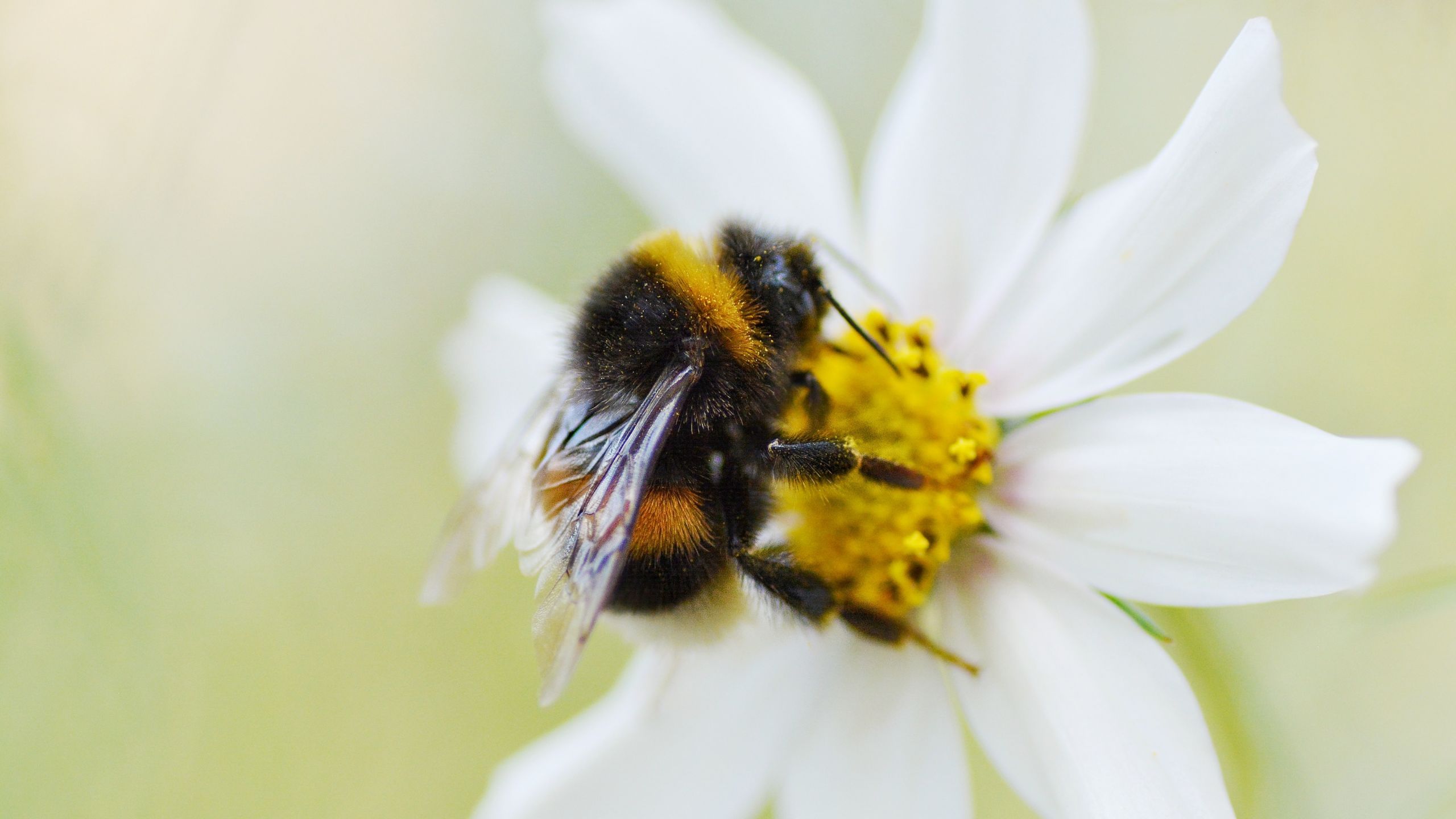Pollinators include bees, birds, beetles, and butterflies. They sustain our ecosystems, allowing plants to breed, seed and fruit – bringing us ‘one in every three’ bites of food, and supporting food and shelter for a diverse range of creatures to co-exist. With our natural environment in crisis and pollinators in decline, this precious resource needs our attention. Our mission is to promote the health of pollinators, through conservation, education, and community projects and today we celebrate the humble bumble bee.
There are about 300 types of bumblebees around the world. Eighteen of the 24 different species found in the UK are considered to be social bees. These bees make nests and live together, they collect pollen and follow a caste system. There are seven main types of bumblebee species in the UK, referred to as “The Big 7”.
1. Red-Tailed Bumblebee (Bombus Lapidarius)
The Red-tailed Bumblebee is extremely common in gardens, farmland, hedgerows, woodlands, and any place across the UK that has flowers for it to feed on. You can begin to find them in the early spring and buzzing around until the autumn begins and the cooler months roll in. The Red-Tailed Queen Bumblebee emerges from hibernation first and will lay her eggs that will turn into healthy workers who will look after the nest. Males tend to come out later on and mate with possible future queens. Of course, when the autumn comes, the males and the previous queen die while the rest go into hibernation.
The females are large and black with their red tail being the only pop of colour. However, the males are smaller and, along with the red tail, they sport two yellow stripes on the thorax and one right at the bottom of their abdomen. Although the males’ tail tends to fade very quickly and so, it may appear white or yellow, depending on how young or worn out the specimen is.
They are very sociable insects that nest under stones or in deserted underground burrows.
2. Early Bumblebee (Bombus Pratorum)
The Early Bumblebee is the most abundant species of bumblebee across the UK. They sport a red tail which is commonly confused with the very similar Red-tailed bumblebee. However, the extent and richness of the red tail on Early bumblebees is always distinctly smaller and has more of a burnt orange hue. The workers of this species tend to lose their yellow abdominal stripe, or it is very much reduced. On the other hand, the males are usually massively yellow and even sport yellow facial hairs too. The Early bumblebee is relatively small when compared with other species.
From February onwards (hence the English name), the Bombus Pratorum can be found all across the UK. In meadows, parks and gardens. Places where Lavender, Sage, Thistles, Daisies, White Clover and Cotoneaster grow. The queens, however, tend to flock to Rhododendrons more. The Early bumblebee nests (sometimes seen in bird boxes, old nests and tree holes) only last around 14 weeks — decidedly shorter than other types of bumblebee nests. When the new queen starts to reign, she immediately begins the nest and does not hibernate. Once over, the nest will have housed any number of individuals from 50 to even 120!
3. Common Carder Bumblebee (Bombus Pascuorum)
The Common Carder Bumblebee is a widespread and plentiful species found all across the UK. The males, queens and workers of the Common Carder bumblebee look extremely similar (no clearly depicted tail and ginger all over). However, the females tend to have white to creamy thorax sides while males have yellow, clearly defined facial hair.
Usually, you will find these Common Carder bumblebees between June and October in grassy lands and gardens throughout the United Kingdom. Be careful though, as they create their nests above ground in tangles of weeds, directly beneath the surface soil, grass mounds and old rodent runs.
4. White-tailed Bumblebee (Bombus lucorum)
The White-tailed bumblebee is found in a wide array of habitats around the UK. Also, it is one of the usual black and yellow type of bumblebees. This type has a lemon kind of yellow band at the very top of the thorax, paired with a brighter yellow stripe in the middle and a completely white tail. However, the males have yellow facial hairs (unlike their female counterparts) and tend to be far more yellow than the females.
White-tailed bumblebees are really common and can be seen emerging in the spring. Usually, they will feed on flowers right up until the autumn season begins again. Across the UK, the White-tailed bumblebee can be found in woodlands, hedgerows, heathland, farmland and gardens — anywhere that the right flowers grow for them to feed on. Since this species have a relatively short tongue, they normally prefer to forage on daisies and flowers with easy-to-reach pollen spots.
5. Buff-Tailed Bumblebee (Bombus Terrestris)
Buff-tailed bumblebees are the giants of the bumblebee world. A plentiful species throughout many habitats up and down the UK, the Bombus Terrestris is by far one of the earliest bees to be spotted in gardens. With the large queens often the first to be seen around February or March time, depending on the weather.
Typically, they nest in the ground of parks and gardens where mice have previously made nests for their young. They can be quite large and house around 500 Buff-tailed bumblebees. The tails of workers and males of this type of bumblebee species are white, while the only kind who has a buff-coloured tail are the queens. The Bombus Terrestris queens are very big and thus, pretty distinctive, they can be around 18mm in length.
The greatest aspect of these Buff-tailed bumblebees is that they are smart when it comes to nectar collecting. If they find a flower that is too long for their tongue, they will bite a hole in the bottom of it so they can easily extract it. Giving them the nickname of ‘nectar robbers’.
6. Garden Bumblebee (Bombus Hortorum)
The Garden Bumblebee is widely spread throughout the entirety of the United Kingdom. They tend to spend their time in people’s gardens. They mostly visit foxgloves, Honeysuckle, Cowslips and Red Clover since they are the perfect shape and length for their tongue. Although, you will not see them until March as they wait for the spring season to start before emerging.
It is fairly difficult to distinguish the three castes (queens, males and workers) from each other in this species of bumblebee. They all have yellow and black thoraxes, a white tail and a yellow stripe around the bottom of their abdomen. Plus, they all have rather scruffy hair that does not grow evenly around them.
7. Tree Bumblebee (Bombus Hypnorum)
The Tree Bumblebee is a pretty new arrival to the United Kingdom; the first recorded sighting in this country was in 2001. Nowadays, it is starting to populate the northern areas like Wales and Southern Scotland. They are becoming increasingly popular throughout England too.
This species nests in bird boxes, spaces in people’s roofs and nests that previously belonged to birds, but generally prefers woodland so you may not see them buzzing around your garden. The Tree Bumblebee emerge during the later dates of February or, if not, towards the beginning of March and then start foraging on flowers like those on raspberry or blackberry bushes. Of course, they feed on other kinds of blossoms too but research shows that they prefer those that bloom with softer fruits.
Unlike other types of bumblebees, the Bombus Hypnorum is easily distinguishable out in the wild. This is all down to the fully ginger thorax, white tail and completely black abdomen. You will find that some of them have a brown upper abdomen, but they always sport a black band before their tail.
How can we help?
Bumblebees are very popular across Britain and not just because of the vital services they provide. They pollinate plants and crops and are an important part of the ecosystem. Unfortunately, bees have been declining rapidly across the past century, however, there are lots of little things we can all do to help bee populations:
• Planting some bumblebee friendly flowers in your garden
• Aim to grow flowers in clumps.
• Avoid using insecticides in your garden
• Create nesting sites and make homemade bee hotels for your garden.

